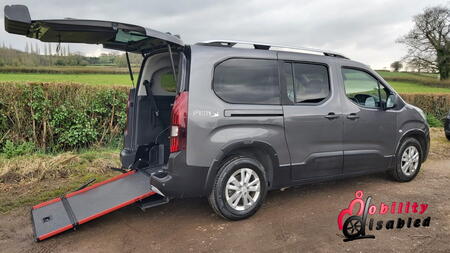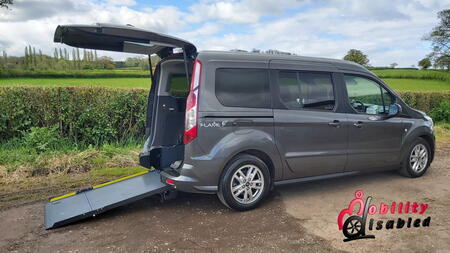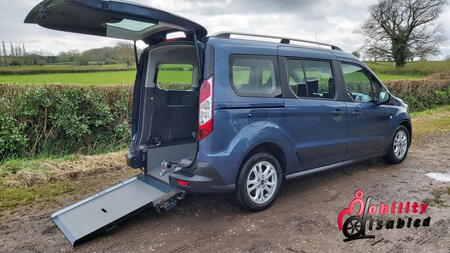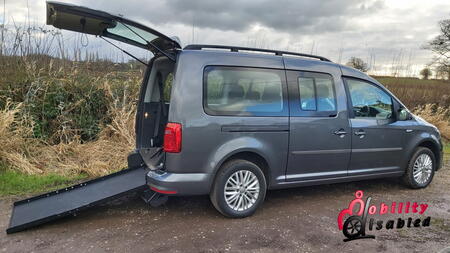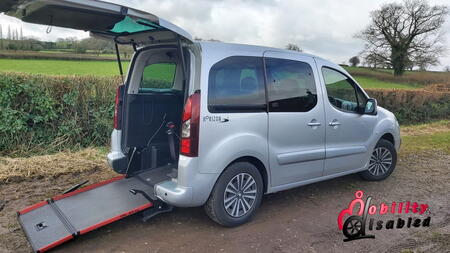MOTs and Wheelchair Access Vehicles (WAVS)
Wheelchair access vehicles (WAVS) and any other motor vehicle which uses the public roads that are 3 years or older require an MOT by law. It is your responsibility as a driver and/or vehicle owner to ensure your wheelchair access vehicle has a valid MOT. It is also extremely important that your WAV is safe, safe for you, safe for your passengers and safe for the wheelchair user.
Each year your wheelchair access vehicle will need to visit a DVSA (Driver Vehicle and Standards Agency) authorised garage for a yearly MOT. This can give a good indication of your vehicles condition and possible components that need checking even after your vehicle has passed its MOT. Here at Mobility Disabled – a supplier of used wheelchair access vehicles (WAVS) ensure that their vehicles have passed an MOT prior to your purchase.
There is a long list of parts of any vehicle including a wheelchair access vehicle that must be tested and checked through the course of the MOT. The initial check is of the wheelchair access vehicles identification to ensure that the VIN and registration number correspond correctly.
Brakes on your wheelchair access vehicle will be checked over, this includes brake fluid, handbrake, brake discs and pads, ABS, EBS as well as other components to ensure that they meet the minimum requirements to pass an MOT.
The steering on your wheelchair access vehicle will also be checked for its mechanical condition. Even if you have lightened power steering – which some drive from/driver transfer wheelchair vehicles have, this will all be assessed to make sure it has reached MOT requirements.
Check your windscreen fluid before you go to an MOT appointment as this will cause your vehicle to fail if the MOT tester is not able to operate the washers to make sure your vehicle has clear visibility. The wipers and windscreen glass condition are needed to be of a certain standard to pass also.
All lights on your wheelchair access vehicle will also be operated to ensure that they are all working. Blown bulbs or any problems with lights on your vehicle such as hazard warning lights, fog lamps, reverse lights and day time running lights will result in an MOT fail. The electrical wiring and vehicle battery storage will also be looked at to make sure it meets minimum standards of the DVSA.
The suspension, springs and wheels and tyres are also checked thoroughly including their load. If your WAV has a TPMS (tyre pressure monitoring system) this also forms part of the MOT. It is advisable to check tyres and tyre pressures on occasion to make sure they are of the recommended standard from the vehicle manufacturer. Given that your WAV will tend to carry more weight because of the wheelchair, passengers, driver and also any other disability equipment it may be that your tyres need the higher pressure indicated on the driver door panel. Here at Mobility Disabled we are happy to offer any advice in relation to this and our used WAV’s we have for sale.
The structure and bodywork of your WAV is inspected and this will also include the exhaust system – if there is a lowered floor on your wheelchair access vehicle (and therefore a modified exhaust) this will not cause a problem with the MOT test unless there is a fault with it, it will be assessed as any other exhaust system on any other vehicle. Whilst the exhaust system is checked, your wheelchair access vehicle will also be checked for emissions ensuring that it achieves the required standard. Any dashboard lights that stay lit may also be an MOT failure and so too will any fluid leaks from any part of the vehicle. The doors, catches and seats are also checked for their safety.
Seatbelts and restraint systems are examined to ensure they are properly fitted, in accordance with the law, and work effectively. Under section 7.1 the MOT tester must inspect all seat belts fitted, child restraints and seats that are permanently attached to the vehicle using the isofix mountings or nuts and bolts; as well as anchorages for the securing of disabled persons with belts or wheelchairs, so thankfully this will offer some peace of mind that your wheelchair securing system on your particular WAV is safe.
Full information of all the checks that are made on a vehicle during an MOT, can be found on the gov.uk web site, here is the link for your information MOT guidance gov.uk
A wheelchair accessible vehicle is not a cheap investment, many vehicles that are converted to a WAV cost more than their standard counterpart, so looking after it is crucial. Not only that, it is carrying a wheelchair user and the last thing you need is a breakdown or it taken off the road for urgent repairs. A maintenance programme is an essential part of owning an adapted vehicle. This includes a yearly MOT, regular servicing at the recommended intervals and also regular visual checks – are your wipers working and do you have fluid? Are your tyre pressures and tyres OK? Do your lights work? – get someone to help check them with you. Check theoil, water and other fluids regularly and have things investigated if lights appear on the dash (such as an engine management light)or something doesn’t feel right with the WAV.
If you have any problem or query with any wheelchair accessible vehicle that you have purchased from us here at Mobility Disabled – whether it still has or warranty or not – we will always help and give advice and guidance. We understand the importance of your WAV.
Wheelchair access vehicles (WAVS) and any other motor vehicle which uses the public roads that are 3 years or older require an MOT by law. It is your responsibility as a driver and/or vehicle owner to ensure your wheelchair access vehicle has a valid MOT. It is also extremely important that your WAV is safe, safe for you, safe for your passengers and safe for the wheelchair user.
Each year your wheelchair access vehicle will need to visit a DVSA (Driver Vehicle and Standards Agency) authorised garage for a yearly MOT. This can give a good indication of your vehicles condition and possible components that need checking even after your vehicle has passed its MOT. Here at Mobility Disabled – a supplier of used wheelchair access vehicles (WAVS) ensure that their vehicles have passed an MOT prior to your purchase.
There is a long list of parts of any vehicle including a wheelchair access vehicle that must be tested and checked through the course of the MOT. The initial check is of the wheelchair access vehicles identification to ensure that the VIN and registration number correspond correctly.
Brakes on your wheelchair access vehicle will be checked over, this includes brake fluid, handbrake, brake discs and pads, ABS, EBS as well as other components to ensure that they meet the minimum requirements to pass an MOT.
The steering on your wheelchair access vehicle will also be checked for its mechanical condition. Even if you have lightened power steering – which some drive from/driver transfer wheelchair vehicles have, this will all be assessed to make sure it has reached MOT requirements.
Check your windscreen fluid before you go to an MOT appointment as this will cause your vehicle to fail if the MOT tester is not able to operate the washers to make sure your vehicle has clear visibility. The wipers and windscreen glass condition are needed to be of a certain standard to pass also.
All lights on your wheelchair access vehicle will also be operated to ensure that they are all working. Blown bulbs or any problems with lights on your vehicle such as hazard warning lights, fog lamps, reverse lights and day time running lights will result in an MOT fail. The electrical wiring and vehicle battery storage will also be looked at to make sure it meets minimum standards of the DVSA.
The suspension, springs and wheels and tyres are also checked thoroughly including their load. If your WAV has a TPMS (tyre pressure monitoring system) this also forms part of the MOT. It is advisable to check tyres and tyre pressures on occasion to make sure they are of the recommended standard from the vehicle manufacturer. Given that your WAV will tend to carry more weight because of the wheelchair, passengers, driver and also any other disability equipment it may be that your tyres need the higher pressure indicated on the driver door panel. Here at Mobility Disabled we are happy to offer any advice in relation to this and our used WAV’s we have for sale.
The structure and bodywork of your WAV is inspected and this will also include the exhaust system – if there is a lowered floor on your wheelchair access vehicle (and therefore a modified exhaust) this will not cause a problem with the MOT test unless there is a fault with it, it will be assessed as any other exhaust system on any other vehicle. Whilst the exhaust system is checked, your wheelchair access vehicle will also be checked for emissions ensuring that it achieves the required standard. Any dashboard lights that stay lit may also be an MOT failure and so too will any fluid leaks from any part of the vehicle. The doors, catches and seats are also checked for their safety.
Seatbelts and restraint systems are examined to ensure they are properly fitted, in accordance with the law, and work effectively. Under section 7.1 the MOT tester must inspect all seat belts fitted, child restraints and seats that are permanently attached to the vehicle using the isofix mountings or nuts and bolts; as well as anchorages for the securing of disabled persons with belts or wheelchairs, so thankfully this will offer some peace of mind that your wheelchair securing system on your particular WAV is safe.
Full information of all the checks that are made on a vehicle during an MOT, can be found on the gov.uk web site, here is the link for your information MOT guidance gov.uk
A wheelchair accessible vehicle is not a cheap investment, many vehicles that are converted to a WAV cost more than their standard counterpart, so looking after it is crucial. Not only that, it is carrying a wheelchair user and the last thing you need is a breakdown or it taken off the road for urgent repairs. A maintenance programme is an essential part of owning an adapted vehicle. This includes a yearly MOT, regular servicing at the recommended intervals and also regular visual checks – are your wipers working and do you have fluid? Are your tyre pressures and tyres OK? Do your lights work? – get someone to help check them with you. Check theoil, water and other fluids regularly and have things investigated if lights appear on the dash (such as an engine management light)or something doesn’t feel right with the WAV.
If you have any problem or query with any wheelchair accessible vehicle that you have purchased from us here at Mobility Disabled – whether it still has or warranty or not – we will always help and give advice and guidance. We understand the importance of your WAV.
Customer Reviews
See All
Thank you so much for the proactive, responsive and supportive way you handled our viewings and sale. A very smooth and professional process throughou... Read More
Amjad Darr
Fantastic company family run buisness easy to deal with and excellent vehicle our vehicle come with a 12 month warranty with no additional charge wow!... Read More
John Smith
Contact Details
Kington GarageKington Lane
Kington
Thornbury
Bristol
BS35 1NH 0333 200 8593 (local rate charges) 07305 049 640 sales@mobilitydisabled.co.uk

 Wheelchair CITROEN
Wheelchair CITROEN Wheelchair FIAT
Wheelchair FIAT Wheelchair FORD
Wheelchair FORD Wheelchair PEUGEOT
Wheelchair PEUGEOT Wheelchair VOLKSWAGEN
Wheelchair VOLKSWAGEN